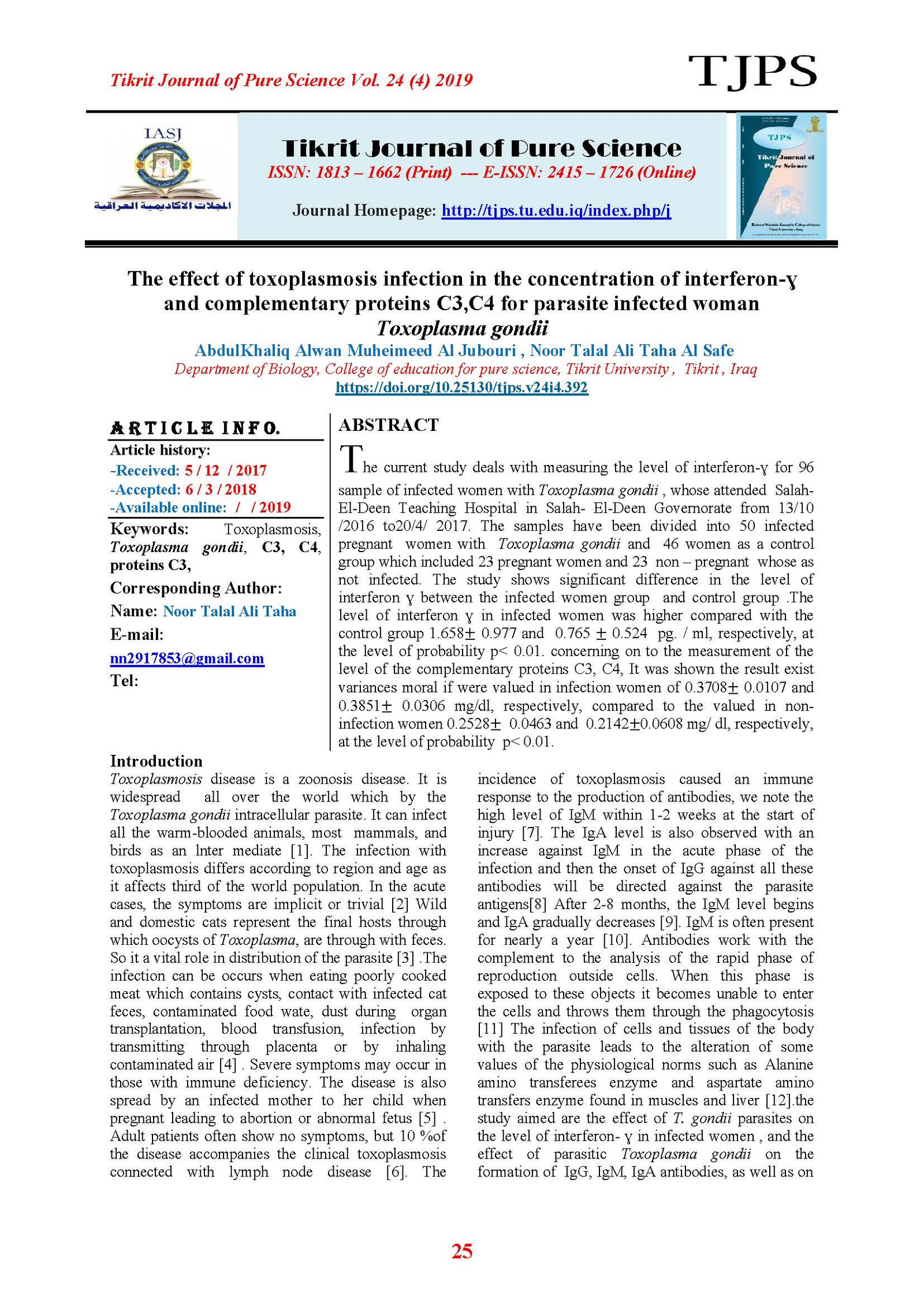The effect of toxoplasmosis infection in the concentration of interferon-ɣ and complementary proteins C3,C4 for parasite infected woman Toxoplasma gondii
Main Article Content
Abstract
The current study deals with measuring the level of interferon-ɣ لfor 96 sample of infected women with Toxoplasma gondii , whose attended Salah- El-Deen Teaching Hospital in Salah- El-Deen Governorate from 13/10 /201 to 2017/4/20 . The samples have been divided into50 50 infected pregnant women with ToxoplasmagondiiToxoplasma gondii and 46 women as a control group which included 23 pregnant women 23and 23 non – pregnant whose as not infectedT.gondii. The study shows significant difference in the level of interferon between the infected women group and control group .The level of interferon ɣ in infected women was higher compared with the control group 1.658 0.977 0.977 and ) (,ah 0.7650.765 0.524 0.524) pg. / ml, respectively, at the level of probability 0.01p< .0.01>p concerning on to the measurement of the level of the complementary proteins C3 ,C4)C3, C4),It was shown the result exist variances moral if were valued in infection women ofC3,C4) 0.3708 0.0107 0.0107 and) ( 0.38510.3851 0.0306 0.0306) mg/dl, respectively, compared to the valued in non-infection women0.2528 0.2528 0.0463 0.0463 and) ( 0.2142 0.2142 0.06080.0608) mg/ dl, respectively, at the level of probability 0.01 p<. 0.01. >
Article Details

This work is licensed under a Creative Commons Attribution 4.0 International License.
Tikrit Journal of Pure Science is licensed under the Creative Commons Attribution 4.0 International License, which allows users to copy, create extracts, abstracts, and new works from the article, alter and revise the article, and make commercial use of the article (including reuse and/or resale of the article by commercial entities), provided the user gives appropriate credit (with a link to the formal publication through the relevant DOI), provides a link to the license, indicates if changes were made, and the licensor is not represented as endorsing the use made of the work. The authors hold the copyright for their published work on the Tikrit J. Pure Sci. website, while Tikrit J. Pure Sci. is responsible for appreciate citation of their work, which is released under CC-BY-4.0, enabling the unrestricted use, distribution, and reproduction of an article in any medium, provided that the original work is properly cited.
References
[1] Asgari, Q.; Mehrabani, D.; Moazzeni, M.; Akrami – Mohajeri, F.; Motazedian, M. H. and Hatam, G. R.(2009). The Seroprevalence of ovine toxoplasmosis in Fares Province, Southern Iran. Asian J. Anim. Vet. Adv., 4:332 – 336.
[2] Vasan, S.; Tsuji, M.(2009). Toxoplasmosis .In :Satoskar , A. R.; Simon, G.L.; Hotez, P. J. and Tsuji, M. (eds.) . Medical parasitology . Landes Bioscience , Texas: 190-194.
[3] Cenci-Goga, B.T.; Rossitto, P.V.; Sechi, P.; McCrindle, C. M. and Cullor, J.S.(2011). Toxoplasma in animals, food, and humans: an old parasite of new concern. Food borne Pathog. Dis, 8: 751-762.
[4] Montoya, J.G. and Liesenfeld, O. (2004). Toxoplasmosis. Lancet. 363:1965-1976.
[5] Dalimi, A. and A. Abdoli (2012). Latent Toxoplasmosis and Human. Iranian J. Parasitol,
7(1):1-17.
[6] Radostits, O.; Gay, C .; Hinchcliff, K . and Constable, P.(2007). Veterinary Medicine:A textbook of the diseases of cattle, horse, sheep, pigs and goat, Saunders, Elsevier, 26: 1518-1522.
[7] Fox, B.A ; Gigley, J.P. and Bzik, D.J. (2004). Toxoplasma gondii lacks the enzymes required for de novo arginine biosynthesis and arginine starvation triggers cyst formation. Int. J. Parasitol, 34(3):323-331
[8] Nascimento, F.R.F.; Calich, V.L.G.; Rodríguez, D. and Russo, F.M. (2011). Dual role for nitric oxide in paracoccidioidomycosis: Essential for resistance, but overproduction associated with susceptibility. Infect. Immun, 79(6):2470-2480.
[9] Mcleod, R. and Dowel, M.C.(2000).Basic immunology: the fetus and new born in: Ambrio-Sc Thomosp and Peterson. Ed. Congenital Toxoplasmosis .Spruiger, Belui, 16:37-68.
[10] Roitt, I., Brostoff, J. and Male, D. (2001). Parasitology and vector biology 2nd ed. Acaademic press. P 165-178.
[11] Correa, D., Canedo - solares, I. and Ortiz - AlegrI, L. (2007). Congenital compartments of the host. Parasite. Immunol., 29: 651-660.
[12] Flori, p.; Bellete , B. and crampe, C.(2008).A. technique for dating Toxoplasmosis in pregnancy and comparison with the vidas anti Toxoplasma IgG avidity tests. Clin . Microbial. Infect, 14:282-249.
[13] Mahalakshmi, B., Therese, K. L. and Mad have, H. N.(2006). Diagnostic. value of specific local antibody production and nucleic acid amplification technique; nested polymerase chain reaction (rPcR) in
clinically suspected ocular Toxoplasmosis. Ocul. Immunol. Inflamm, 14:105-112.
[14] Shaw, M.H.; Freeman, G.J.; Scott, M.F.; Fox, B.A. ; Bzik, D.J. ;Belkaid, Y. and Yap, G.S. (2006). Tyk2 negatively regulates adaptive Th1 immunity by mediating IL-10 signaling and promoting IFN-c dependent IL-10 reactivation. J. Immunol, 176:7263-7271.
[15] Pickup, J. C. (2004) . Inflammation and activated innate immunity in the pathogenesis of type 2 diabetes . Diabetes Care, 27(3): 813-823.
[16] Dubey, J.P.(2010).Toxoplasmosis of animal and human. CRC Press Inc. Boca Raton: New York: 1 – 313.
[17] Jiménez – Coello, M.; Acosta – Viana, K.Y.; Guzmán – Marín, E.; Puerto – Solís, M. and Ortega – Pacheco, A. (2012). Toxoplasmosis: A relevant zoonotic food borne disease in tropical conditions. Afr. J. Micro biol. Res, 6(12): 2956-2964.
[18] Rich, R.R; Fleisher, T.A.; Shearer, W. T., Schroeder Jr., H. W.; Frew, A.J. & Weyand, C. M. (2008) . Clincal immunology principles and practice .3rd edn., China : 1578 pp.
[19] Zhou, P. ; Chen, Z. ; Li, H. ; Zheng, H.H ; He, S. ; Lin, R. and Zhu, X. (2011). Toxoplasma gondii infection in humans in China. Parasites and Vectors, 4(165):1-9.
[20] Al-Ani, S.K. (2011). Epidermiological and immunological study of toxoplasmosis among abortive women in Al-Ramadi city . M. Sc. Thesis , Coll Med, Al-Anbar Univ.
[21] Filisetti, D. and Candolfi, E. (2004). Immune response to Toxoplasma gondii. Ann Ist Super Sanità; 40(1): 71-80.
